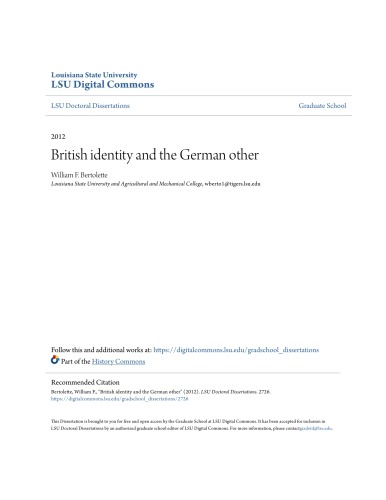Product desciption
British Identity And The German Other William F Bertolette by William F. Bertolette instant download after payment.
British identity evolved through conscious comparisons with foreigners as well as through the cultivation of indigenous social, economic and political institutions. The German other in nineteenth- and twentieth-century Britain, like the French other in previous centuries, provided a psychological path toward unity against a perceived common enemy. Because German stereotypes brought into sharp focus what the British believed themselves not to be, they provided a framework for defining Britishness beyond Britain’s own internal divisions of race, ethnicity, class, religion, gender and politics. Post-World War II devolution and European integration have since revived British internal national divisions. The image of innocuous Old Germany as England’s “poor relation,” a backward cluster of feudal states, gave way during the nineteenth century to the stereotype of New Germany, Britain’s archenemy and imperial rival. After unification in 1871, German economic growth and imperial ambitions became hot topics for commentary in British journals. But the stereotypical “German Michael,” or rustic simpleton, and other images of passive Old Germany lingered on as a “straw man” for alarmists to dispel with New German stereotypes of aggressive militarism and Anglophobic nationalism. Some Germanophobes, however, and many Germanophiles, clung to older stereotypes as a form of escapism or wishful thinking, the former believing that national character deficiencies would foil German ambitions, the latter that German idealism and good sense would eventually resolve Anglo-German disputes. The British entente with France in 1904, and Russia in 1907, ended more than a decade of Anglo-German alliance attempts. These missed opportunities were thwarted by mutual distrust, opposing geopolitical strategies, diplomatic maneuvering and, ultimately, naval rivalry. But national stereotypes in public media also contributed a cultural aspect to Anglo-German diplomatic antagonism. British journalists drew upon a rich heritage of German stereotypes, both for polemical argument and for entertaining a national self-image at the expense of the German other. Stereotypes also gained currency through pseudoscientific racial theories and ethnological hierarchies that constituted the nineteenth-century paradigm of innate national character. Because they encapsulate assumed national difference so effectively, stereotypes in print provide a useful perspective on the interface between national identity, public opinion and policy.


